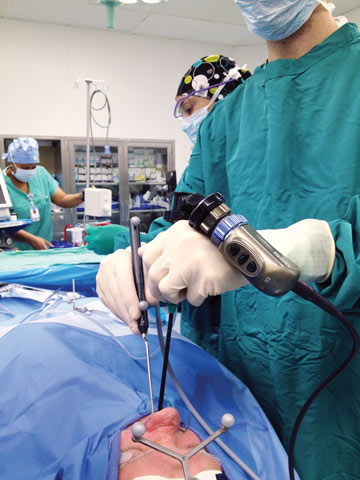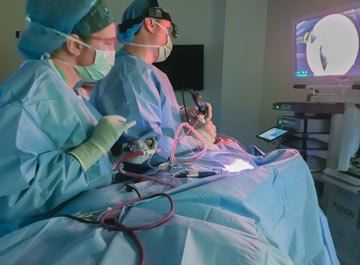Patients seeking treatment for chronic sinus infections want lasting relief fast, and fortunately the latest innovations promise to help physicians deliver those results. ENT navigation systems, improved instruments, drug-eluting stents and improved balloon dilation systems are all promising to improve sinus surgery for patients and physicians alike. Here's what you should know about the latest technological advances.
1 ENT navigation Once reserved for only the most difficult cases, ENT navigation is now commonplace in most sinus surgeon's toolkits, says Jeffrey S. Wolf, MD, FACS, professor of otorhinolaryngology-head and neck surgery at the University of Maryland School of Medicine. "I would think that it's being used by many surgeons a majority of the time," he says. "It is not the standard of care yet, but it is widely used."
The latest systems help doctors navigate through the sinuses using a 3D map that is created by using CT scans of the patient. By viewing 3-dimensional images of the sinuses during surgery, the computer imaging can give surgeons better visibility in guiding the surgical instruments around vital structures such as the optic nerve and skull base. These images help surgeons avoid orbital and skull base injuries, and are especially helpful when working on patients with altered anatomy from severe polyps or prior procedures, says Dr. Wolf. "Navigation can help reinforce where you are in the sinus cavity and reduce the risk of complications," he says.
The latest ENT navigation systems also promise to be smaller, more portable and more accurate than previous models. Mani H. Zadeh, MD, FACS, an ENT surgeon with his own practice in Los Angeles, Calif., notes that though the technology has been around for roughly 15 years, it has "changed quite a bit" over the last 5 years.
"They have become more accurate, with an intraoperative accuracy of less than 1mm, and they're often easier to set up," he says. "They've become more affordable as well."
Dr. Zadeh notes that image-guided surgery can benefit both the novice and the expert ENT surgeon. It all depends on the surgeon's skill and experience level, from those who specialize in sinus surgery and are performing revision or complex procedures to those who might not do a lot of sinus cases.
"While this technology is not meant to replace knowledge of anatomy or surgical skill," says Dr. Zadeh, "it can be used to get a secondary assurance that the surgeon is doing a complete surgery and also reduce the risk of complications to surrounding structures such as the orbit or the brain."
2 Improved instruments New instruments for functional endoscopic sinus surgery (FESS) are smaller and more maneuverable, making the process more minimally invasive and easier for surgeons, says Peter Svider, MD, a fellow in rhinology and endoscopic skull base surgery at Rutgers New Jersey Medical School.
Endoscopes continue to improve, with some smaller than 3mm while providing high-definition images. Dr. Zadeh notes that the video towers have also improved, and are now providing higher definition video with higher clarity.
"Every year it seems, there are new endoscopes that let us see what we're doing a whole lot better," adds Dr. Svider. "Improved visualization can help surgeons minimize any trauma to structures and minimize blood loss."
Additionally, Dr. Svider notes that instruments such as small microdebriders — traditionally used in orthopedic cases — cut tissue while providing suction to remove tissue and polyps. Though original designs were cumbersome, Dr. Svider notes that the ergonomics of these devices makes them easier to use. "The latest models feature pistol grips and other features that let you rotate the blade in a more efficient manner," he says.
Image-guided surgery can benefit both the novice and the expert ENT surgeon.
3 Balloon sinuplasty Balloon sinuplasty may not be a new innovation, but physicians continue to push the envelope by performing this minimally invasive procedure more and more in office-based settings. It's also one of the largest growing treatments for sinusitis, notes Dr. Svider, who co-authored a study that showed that balloon sinuplasty have continued to grow in popularity while traditional FESS has stayed roughly the same.
However, Dr. Zadeh says that while the procedure is beneficial to many patients, physicians need to be sure that the treatment is appropriate for the patient.
"One concern many have is the selection of an appropriate candidate for the procedure," says Dr. Zadeh. "But for those who need it, it's an incredible treatment."
To ensure the proper patients are selected for the treatment, he suggests physicians follow the American Academy of Otolaryngology's criteria on which patients are best suited for the procedure.
The procedure can be performed in the office, under local and topical anesthesia, and patients remain awake for the procedure, allowing for a quicker recovery, says Dr. Zadeh. The balloon catheter is inserted into the inflamed sinus, typically the frontal and/or maxillary, and inflated to expand and restructure the sinus opening. Saline is then sprayed into the inflamed sinus to flush out pus and mucus, and the system is removed, allowing the sinus to drain.
Dr. Zadeh, who performs balloon sinuplasties at his office, says that there are two big benefits patients enjoy from moving this procedure to the office. The first is that it doesn't require general anesthesia, so patients can come, get the procedure and drive themselves home. The second is that from a cost standpoint, the patient doesn't need to pay a facility fee or for general anesthesia, "so it's typically a cost savings for them."
"The pendulum is swinging toward favoring being less invasive when it comes to sinus surgery," he adds. "In the past, a lot of times we would have to access the sinus surgically via tissue removal. Now with the balloon sinuplasty, it's less invasive and we can often get the same results without doing a big surgery."
4 Drug-eluting stents Drug-eluting implants are one of the fastest growing areas of sinus surgery. These stents promise to provide 2 big benefits to surgeons and their patients: mechanical support in the sinus while placing topical steroid in the cavity to reduce inflammation, says Dr. Wolf.
.svg?sfvrsn=be606e78_3)


.svg?sfvrsn=56b2f850_5)